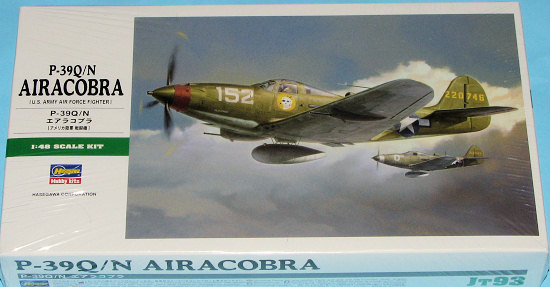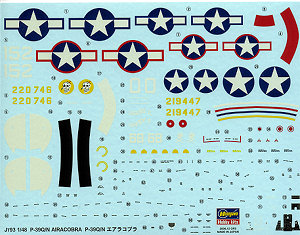
| KIT: | Hasegawa 1/48 P-39N/Q Airacobra |
| KIT #: | 09093 |
| PRICE: | $24.75 at GreatModels |
| DECALS: | Three options |
| REVIEWER: | Scott Van Aken |
| NOTES: |

| HISTORY |
The XP-39 made its initial flight in April 1939 at Wright Field, Ohio, The P-39's unusual design incorporated its V-12 Allison engine mounted in the middle of the fuselage, just behind the cockpit, driving the propeller through a driveshaft passing between the pilot's feet. The main purpose of this configuration was to free up space for the heavy main armament, a 37 mm T9 cannon firing through the center of the propeller hub for optimum accuracy and stability when firing. Although a devastating weapon, it was prone to jamming. A secondary benefit of the mid-engine arrangement was to create a smooth and streamlined nose profile. The weight distribution necessitated a tricycle undercarriage, a first among American fighters. Entry to the cockpit was through side doors (mounted on both sides of the cockpit) rather than a sliding canopy. Its unique engine location behind the cockpit caused some pilot concern at first, but experience showed that this was no more of a hazard in a crash landing than with an engine located forward of the cockpit.
The weight distribution of the P-39 supposedly is the reason for its tendency to enter a dangerous flat spin — a characteristic Soviet test pilots were able to demonstrate to the then-skeptical manufacturer who had been unable to reproduce the effect. After extensive tests, it was determined that the spin could only be induced if the plane was improperly loaded, with no ammunition in the front compartment. The flight manual specifically noted that one had to ballast the front ammunition compartment with the appropriate weight of shell casings to achieve a reasonable center of gravity. High speed controls were light ala P-51, thus high speed turns and pull-outs were not the strength test of a P-40 or P-47, never mind the Zero or Me 109. The P-39 had to be held in a dive since it wanted to level out, reminiscent of the Spitfire. Redline dive speed was a respectable 525 mph for the P-39 'Cobra.
The P-39's Allison V-1710 engine had a single-speed, single-stage supercharger, which brought about a decrease of performance compared to the promising prototype fitted with an exhaust-driven turbo-supercharger. The production P-39's heavier weight combined with the poor performance of the Allison engine, limited the high-altitude capabilities of the fighter. The P-39's altitude performance was markedly inferior to the contemporary European fighters and, as a result, the first USAAF fighter units in the European Theater were equipped with the Spitfire V (which coincidentally also featured a single-speed, single-stage supercharger). However, the P-39D's roll rate was 75 degrees per second at 235 mph– better than the A6M2, F4F, F6F or P-38 up to 265 mph.
Above the V-1710's full throttle height of about 17,000 ft (5,000 m), the P-39's performance dropped off rapidly. This limited its usefulness in traditional fighter missions in Europe as well as in the Pacific, where it was not uncommon for Japanese bombers to attack at altitudes above the P-39's operational ceiling (which in the tropical hot air inevitably was lower than in moderate climates).
A naval version with taildragger landing gear, the XFL-1 Airabonita, was ordered as a competitor to the F4U Corsair and XF5F Skyrocket, but after a troublesome and protracted development and testing period, was rejected by the Navy.
By the time of the Pearl Harbor attack, nearly 600 had been built. When P-39 production ended in August 1944, Bell had built 9,584 Airacobras, of which 4,773 were sent to the Soviet Union through the Lend-Lease program.
Though the P-39 held its own during the opening year of the war in the Pacific, the most successful use of the P-39 was in the hands of the VVS (Soviet Air Force). The tactical environment of the Eastern Front did not demand the extreme high-altitude operations that the RAF and USAAF employed with their big bombers. The P-39's inherent weakness was its lack of a turbocharger but in the relatively low-altitude operations in the East, this was not as great a handicap. The low-speed, low-altitude turning nature of most air combat on the Russian Front suited the P-39's strengths: sturdy construction, reliable radio gear and adequate firepower. It was common for the Soviet pilots to remove the wing guns and rely only the cannon and nose machine guns as armament. The P-39 was well liked by VVS pilots. The second-highest scoring Allied ace, Pokryshkin, flew the P-39 from late 1942 until the end of the war; his unofficial score in the Airacobra stands at nearly 60 Luftwaffe aircraft. His wingman Grigori Aleksandrovich Rechkalov scored 57 victories with the P-39. This is the highest score ever gained by any pilot with any US-made aircraft. The usual nickname for the Airacobra in the VVS was Kobrusha, "dear little cobra".
The variants that one can do with this kit are:
| THE KIT |
 I
was surprised that no one had done a preview on this kit so here it is.
I
was surprised that no one had done a preview on this kit so here it is.
Molded in Hasegawa's usual grey plastic, it is everything that Hasegawa has come to mean when one goes for 1/48 kits. The detailing is superlative and the number of different variants that will be done from a boxing is determined by a number of spots for inserts. While these do extend the life of the mold and make things quite interesting, it also increases the number of parts and opportunities for building errors.
However, accuracy is the buzz word for most and with this method, it can well be achieved. For instance, this kit offers two different styles of main gear wheel and three different nose wheels. There are also two different exhaust; one tubular and the other a 'fishtail' design that is flattened on the end. The kit has the doors in clear plastic, similar to how Eduard molded theirs and though they seem to be the right shape (Eduard's are rather flat), apparently the fit is still not perfect. There are also holes to open for various vents and one has a choice of centerline drop tank or bomb.
Cockpit detail is excellent, needing little more than
some belts to liven things up. This one will need nose ballast and there is
considerable room for that to be added. I was hoping for a four blade prop to be
included in this boxing, but that is not the case. I'm also not sure if this
propeller is longer than those on previous, earlier kits, though it appears it
should be. For molding glitches, I found ejector pin marks on the inside of the
main gear doors, part of the nose well and a few interior bits, though the
latter seems  to be covered when
the kit is done. As is the norm, many of the optional items are dependent on
what markings option one chooses and that is pointed out in the instructions.
One can also use decals in place of the raised detail for the cockpit
instruments.
to be covered when
the kit is done. As is the norm, many of the optional items are dependent on
what markings option one chooses and that is pointed out in the instructions.
One can also use decals in place of the raised detail for the cockpit
instruments.
Instructions are superbly done, with paint references given for the Gunze line of paints. There are three markings options in this one. Two of them are on the box art with the foreground aircraft being a P-39Q from the 357 FG as allegedly flown by 'Bud' Anderson while in the States in late 1943. The background aircraft is another P-39Q flown by the 375 FG wing commander. All the various stripes and white wing tips on the second option are provided on the decal sheet. The third options is a P-39N with the 347 FG at Guadalcanal in June of 1943. It is a lot less decorated than the Stateside aircraft. All three are in OD/Neutral Grey. This sheet looks like one of the newer generation of Hasegawa sheets where the white areas are white and they won't turn into a mess with setting solutions.
| CONCLUSIONS |
All who have built this kit have commented on how trouble-free it is and how it is so much nicer than the previous kits by Eduard and Monogram. Looking at it, I'd say they are probably right and typical of me, it will probably be a year after introduction that I'll finally get around to mine!
| REFERENCES |
http://en.wikipedia.org
May 2007 You can find this and other fine models and
accessories at GreatModels
If you would like your product reviewed fairly and quickly by a
site that has over 350,000 visitors a month, please
contact
me or see other details in the
Note to
Contributors.